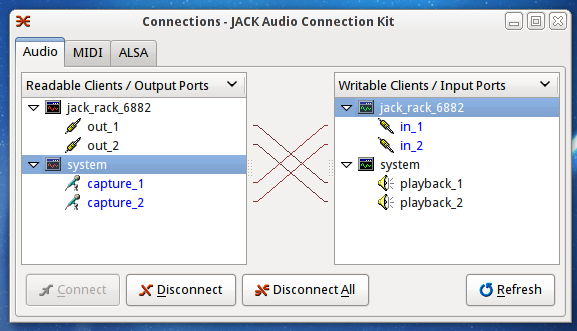Are you a World Cup fan annoyed by the constant sound of the South African vuvuzela horn? Wish you could remove that sound from your World Cup viewing experience? Do you want to learn a little bit about powerful modular effects routing can be on Linux? Either? Both? Call it “football”? “Soccer”? Any way round, we’ve got you covered.
(Disclaimer: I have nothing in particular against the vuvuzela. But here you go, anyway.)
Updated: Via comments, here’s a Mac plug-in for filtering the horn, also a notch filter, and a sign that this is getting a little carried away. (Mostly, I think this is a useful way to learn about JACK, something you can use after the World Cup. But knowing football fans, “after the World Cup” may not be a phrase with any meaning at the moment.)
JACK is a powerful audio API on Linux, and thanks to rich application support for the tool, you can route sound arbitrarily between software tools, making everything on your computer into a kind of virtual studio. (Mac users should check out the excellent JACK OS X implementation.)
Felix Kaechele, a German-based Fedora community member and Fedora Ambassador, uses JACK to filter out sound from his live World Cup feed. If you’re curious about how JACK works and how to add effects to your system (or record a system audio feed, etc.), this is the way to go. The trick here is that PulseAudio, the default sound API on Linux, actually gets routed right into JACK.
Read the full instructions here:
Vuvuzela Filter using Fedora [Felix’ Blog]

Fedora is a superb distribution, and intelligent JACK packaging is a particular strong suit. (Check out the Planet CCRMA project for more.) But part of the strength of Linux is that it is open, so you’ll find these same instructions work on other distributions. In fact, so long as you replace “yum install” with “apt-get install”, you’ll find most of these packages have the same name. (Only “ladspa-swh-plugins” is missing on Ubuntu, though there are other LADSPA plugs available.)
Note that on vanilla Ubuntu, I did need to do one extra step when setting up JACK. When you launch, JACK will actually advise you to do so right in the message window, but here it is, as a reminder:
Please check your /etc/security/limits.conf for the following lines
and correct/add them:
@audio – rtprio 100
@audio – nice -10
After applying these changes, please re-login in order for them to take effect.
These steps tweak real-time performance for better JACK sound results.
Also, I generally like to launch JACK Control with the following command, in order to disable PulseAudio:
pasuspender qjackctl
But in this event, you’d actually install the Pulse module and route Pulse into JACK, as in the instructions.
Setting up Ubuntu is a topic for another article, but there’s a preview. But the musical applications here should be clear: JACK makes it easy to set up a modular rig. Want to add effects to a Pd patch? Record audio from a system application for sampling? Route together some effects to make a virtual stompbox rig for your guitar? Having JACK is a bit like having an extensive patch bay for software.
Let us know how these tips work out for you, or if you’ve got ideas of your own. (And if someone wants to do a Mac version of the tutorial, let us know!)
Via OSTATIC; thanks, Brad Linder!
